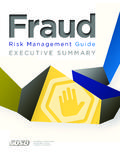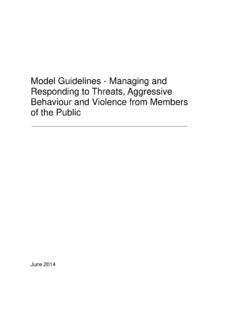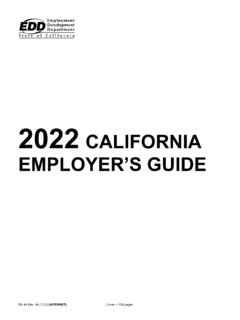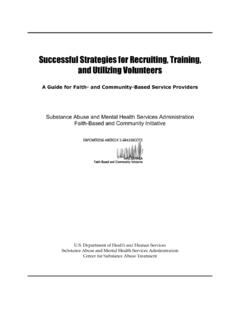Transcription of A Practical Guide to Strategic Planning in Higher Education
1 A Practical Guide to Strategic Planning in Higher Educationby Karen E. HintonA Practical Guide to Strategic Planning in Higher Educationby Karen E. HintonSociety for College and University 2012 by the Society for College and University PlanningAll rights reserved. Published 978-1-937724-13-920120702 About the Society for College and University Planning (SCUP)The Society for College and University Planning is a community of Higher Education Planning professionals that provides its members with the knowledge and resources to establish and achieve institutional Planning goals within the context of best practices and emerging is Integrated Planning ?Integrated Planning is the linking of vision, priorities, people, and the physical institution in a flexible system of evaluation, decision-making and action.
2 It shapes and guides the entire organization as it evolves over time and within its the Society's WorkThis publication is free to SCUP members, who may freely make use of it with their Planning colleagues on campus. It and other SCUP publications are inexpensively priced for nonmembers. Please consider joining the society and supporting more Planning resources for Higher Education more information about SCUP, visit This Book the Author One: Overview of Strategic Planning in Higher Education 7 Section Two: Components of a Strategic Three: Coordinating the Planning Process Four: Assessment and Metrics Five: The Self-Sustaining Planning Process Six: The Critical Impact of Institutional Culture Seven: From Strategic to Operational Eight: A Table of Troublesome Terms Nine: The Relationship of Other Types of Institutional Plans to the Strategic Plan Ten: Summary of Thoughts Eleven.
3 Tips, Techniques, and Templates Cited 48 ForewordOver the course of my career as a Strategic planner in Higher Education , I have worked with a wide variety of individuals who have misconstrued the role of Strategic Planning in the academy. A great number of individuals are unaware of the necessary components of a Strategic plan and what is required to implement and sustain such a plan. Some of the misinformed were consultants in occupations that serve the post-secondary community, and others were members of a college or university. Regardless of their relationship to the academic enterprise, those who misunderstand or are uninformed about Planning practice can be a serious detriment to successful costs of engaging in a poor Planning process range from disillusioned faculty, staff, and students, to poor use of vital resources, to failed accreditation reviews which, in turn, cause an institution to lose funding and prestige.
4 The stakes are high, but the rewards are Higher . A well designed and implemented Strategic Planning process can provide an institution with a forum for campus-wide conversations about important decisions. The process can also be organized to make assessment, resource allocation, and accreditation easier, and be a source of information about progress and achievement with very real meaning to those associated with the institution. This booklet is written to provide a Practical overview of what Strategic Planning should be at the post-secondary level and define the elements of a successful process. The content offers a brief overview of the history of Strategic Planning in the academy from a practitioner s perspective and a more detailed examination of current Planning practice.
5 In some ways the content of this monograph is an examination of the criticism that Strategic Planning as a process is too linear to cross organizational silos and achieve institutional transformation. I believe those who have taken the view of Strategic Planning as a tool of limited use need a better understanding of the is my hope that those who engage in all types of Planning activities on behalf of a post-secondary institution will use this information to educate themselves about what a Strategic plan is and what its potential can be. A Practical Guide to Strategic Planning in Higher Education | 5 About This Book Undergoing a Strategic Planning process can be a monumental task, especially for Higher Education institutions that are attempting a more contemporary model for the first time.
6 Dr. Hinton's Guide shortens the learning curve and unites college leadership with its intuitive, step-by-step approach. It not only takes you through the Planning process, but also provides guidance on how to ensure the plan's long-term success. Kasey McKeeVice President, College AdvancementSt. Charles Community College (SCC) FoundationAbout the AuthorKaren E. Hinton, PhD, has more than twenty-five years of experience in Planning and administration in Higher Education , serving at large and small public and private colleges and universities, a community college, and a university system office. She has developed, facilitated, and managed numerous Strategic plans, accreditation self-studies, and process improvement initiatives in a wide range of a senior associate for Rickes Associates, Inc.
7 , Hinton currently continues to work with institutions, providing leadership and support for Strategic Planning , regional accreditation, and administrative studies. Hinton has taught courses in composition, literature, and research methods, and served as an academic advisor for undergraduate and graduate students. She served as SCUP s membership liaison for New Mexico, up-state New York, and as a board member for the North Atlantic region. She is currently a member of the American Society for Quality. Hinton has made numerous presentations and written articles and reviews for such publications as Knowledge Directions (the journal of The Institute for Knowledge Management) and Planning for Higher author and the society would like to thank Planning for Higher Education Editorial Review Board member, Arnold J.
8 Gelfman, Executive Director, Planning , Assessment & Research, Brookdale Community College, for his meaningful contributions to the development of this Guide . A Practical Guide to Strategic Planning in Higher Education | 6 Section One: Overview of Strategic Planning in Higher EducationFrom the point at which George Keller published his Academic Strategy: The Management Revolution in American Higher Education in 1983, American post-secondary institutions have struggled with the concept of and uses for Strategic Planning in the academy. Prior to Keller, long-range Planning was practiced by most institutions, but this was often a budget-driven, incremental process intended to ensure long-range fiscal Planning .
9 Prior to Keller, Strategic Planning was conducted in the realm of corporate or military operations, where mission driven long-term objectives and short-term actions needed to be efficiently integrated through a type of administrative coordination most colleges and universities never aspired to and March (1974) used the term loosely coupled organization to describe the competing and sometimes opposing operational cultures of the academy. This phrase captures the essence of an organization which, at its core, finds institutionally comprehensive Planning antithetical to many of the activities that give American Higher Education its unique, dynamic character. The emergence of Strategic Planning in Higher Education coincided with the difficulties experienced in all of Education in the 1970s and 1980s, as enrollments began to fluctuate, student demographics started to change, and funding became inconsistent.
10 At this point, futures research and the rise of technology-enabled data collection and analysis pointed the way to Strategic Planning as one solution for developing a proactive stance in the environment of changing demands and declining resources. The difficulties with initial attempts to convert corporate strategies to the culture of Higher Education were legion. Adapting a process designed to motivate assessment-based change within a short timeframe was frustrating at best and ineffective most often. While corporations developed their Planning processes based on market data and customer-driven production, academe was limited in the data it could bring to bear on its issues and did not view itself as serving customers.







